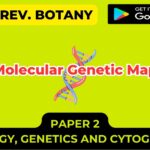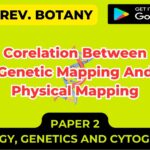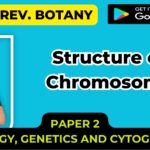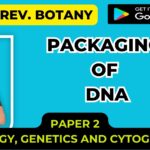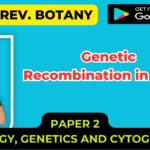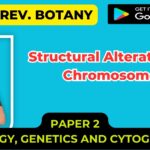Chromosome Mapping Linkage Groups And Genetic Markers
Linkage Groups
- Bateson and Punnett (1905) observed in sweet pea that two pairs of alleles do not assort independently.
- Morgan (1910) found the same phenomenon in drosophila and Hutchinson observed a clear cut case of linkage in maize.
- All these researches found that genes inherit in groups rather than individually.
- This tendency of two or more genes to remain together in the same chromosome during inheritance is referred to as linkage. In other words, linkage is the tendency of genes to be inherited in groups.
1. Linkage involves two or more genes which are located in the same chromosome in a linear fashion.
2. Linkage may involve either dominant genes or recessive genes or some dominant and some recessive genes.
3. Linkage usually involves those genes which are located closely.
4. Presence of linkage leads to higher frequency of parental types than recombinants in a test cross progeny. When two genes are linked the segregation ratio of a test cross progeny deviates significantly from the 1 : 1 : 1 : 1 ratio.
5. Linkage may involve either two or more desirable traits or all undesirable traits or some desirable and some undesirable traits.
6. Linkage is observed for both oligogenic traits as well as polygenic traits. However, it is more common for the former than latter.
7. Besides pleiotropy, linkage is an important cause of genetic correlation between various plant characters.
8. The strength of linkage depends on the distance between the linked genes. Lesser the distance higher the strength and vice versa.
9. If crossing over does not occur, all the genes located in one chromosome are expected to be inherited together. Thus the maximum number of linkage groups in an organism is equal to its haploid chromosome number.
10. Linkage can be broken by repeated inter-mating of randomly selected plants in segregating populations for several generations.
Phases of Linkage of Genes:
- There are two phases of linkage, viz., coupling phase and repulsion phase.
- These phases were given by Bateson and Punett (1905), but they could not give proper interpretation of these terms.
- Later on, Morgan (1910) based on his studies with Drosophila explained that coupling and repulsion are the two aspects of the same phenomenon what we call linkage.
- The coupling and repulsion phases of linkage are briefly described below.
i. Coupling:
- The linkage between two or more either dominant (AB) or recessive (ab) alleles is referred to as coupling.
- A good example of coupling was reported by Hutchinson in maize for the genes governing colour of seed (coloured and colourless) and shape of seed (full and shrunken).
- The coloured seed is governed by dominant gene (C) and full seed is also governed by dominant gene (S). He made cross between plants having coloured full seeds (CCSS) and colourless shrunken seeds (ccss).
- The F1 seeds were coloured full. When the F1 was test crossed with double recessive parent the following results were obtained instead of 1 : 1 : 1 : 1 ratio.

- This indicates that parental combinations are higher than recombination’s, indicating presence of linkage.
- The parental combinations occurred in 96.4% instead of 50% and re-combinations were 3.6% instead of 50% in this case. There are several other cases of coupling in other plant species.
ii. Repulsion:
- The linkage of dominant allele with that of the recessive allele (Ab or aB) is known as repulsion. Hutchinson also observed repulsion phase of linkage in maize.
- He observed this type of linkage when he made cross between plants having coloured shrunken seeds (Cs) with those having colourless full seeds (cS).
- In F1 the seeds were coloured full. By crossing of F1 with double recessive parent the following results were obtained instead of 1 : 1 : 1 : 1 ratio.

- Again parental combinations were higher (97.1%) than expected (50%) and recombination’s were lower (2.9%) than expected (50%).
- Thus in both cases linked genes tend to remain together during hereditary transmission. Haldane (1942) used the terms cis and trans for coupling and repulsion, respectively.
4. Types of Linkage of Genes:
- Linkage is generally classified on the basis of three criteria, viz:
(1) Presence or absence of crossing over,
(2) Genes involved, and
(3) The chromosome involved.
These are briefly described below:
1. Based on Crossing Over:
(i) Complete Linkage:
- Linkage in which crossing over does not occur is known as complete linkage or absolute linkage.
- In other words, when only parental types are obtained from the test cross progeny, it refers to complete linkage. Good example of complete linkage is Drosophila male and female silk moth.
(ii) Incomplete Linkage:
- If some frequency of crossing over also occurs between linked genes, it is known as incomplete linkage.
- To put in other way, when recombination’s are also observed in the test cross progeny, besides parental combinations, it refers to incomplete linkage. Incomplete linkage has been observed in maize, pea,
- Drosophila female and several other organisms.
2. Based on Genes Involved:
(i) Coupling Linkage:
- It refers to linkage either between dominant genes or between recessive genes. Such linkage has been reported in pea, maize and several other crops.
(ii) Repulsion Linkage:
- It refers to linkage of some dominant genes with some recessive genes. This type of linkage has also been observed in pea, maize and several other crops.
3. Based on Chromosome Involved:
(i) Autosomal Linkage:
- It refers to linkage of such genes which are located in other than sex chromosomes (autosomes).
(ii) X-Chromosomal Linkage:
- It refers to the linkage of genes which are located in sex chromosomes.
5. Linkage Groups:
- Linkage group refers to a group of genes which are present in one chromosome.
- In other words, all those genes which are located in one chromosome constitute one linkage group.
- The number of linkage groups is limited in each individual.
- The maximum number of linkage groups is equal to the haploid chromosome number of an organism.
- However, in case of species having dissimilar sex chromosomes, linkage groups are one more than the haploid chromosome number.
- For example, there are ten linkage groups in corn, 7 in garden pea, 7 in barley, 4 in Drosophila melanogaster and 23 in man.
- Genes are assigned to various chromosomes of a species with the help of deletion, monosomic and nullisomic analyses.
- Linkage groups are assigned to different chromosomes in a linear fashion and same sequence as they normally list.
- Generally, a relative length of various linkage groups in a species exhibits a close agreement with the relative length of chromosome in which they exist.
6. Detection of Linkage of Genes:
- Test cross is the most common method of detecting the linkage. In this method, the F1 heterozygous at two loci (say AaBb) is crossed to a double recessive parent (aabb) and the phenotypic ratio of test cross progeny is examined.
- If the phenotypic ratio of test crosses progeny shows 1:1:1:1 ratio of parental and recombinant genotypes, it indicates absence of linkage.
- If the frequency of parental types and recombinant types deviate significantly from the normal test cross ratio of 1 : 1 : 1 : 1, it reveals presence of linkage between two genes under study.
- There is another way to detect the presence or absence of linkage.
- The individual heterozygous at two loci (AaBb) is self-pollinated.
- If there is complete dominance at each locus and no epistasis, the segregation ratio of the progeny will be 9 : 3 : 3 : 1.
- Presence of linkage either in coupling or repulsion phase will lead to significant deviation from 9:3:3:1 ratio. The deviation of observed values from the expected ratio is tested with the help of %2 test.
7. Linkage and Pleiotropy:
- A close association between two or more characters may result either due to linkage or pleiotropy or both. Pleiotropy refers to the control of two or more characters by a single gene.
- A tight linkage between two loci can be confused with pleiotropy.
- The only way to distinguish between linkage and pleiotropy is to find out a crossover product between linked characters.
- Inter-mating in segregating populations may break a tight linkage, but a huge population has to be raised to find out the crossover product.
- If a crossover product is not found in-spite of repeated inter-mating, there seems to be the case of pleiotropy rather than linkage.
8. Linkage Significance in Plant Breeding:
- In plant breeding, linkage has impact in three principal ways.
- Effects of Linkage on the progress of selection, genetic variances and genetic correlation are discussed below:
(i) Effect on Selection:
- Linkage between two or more loci controlling different desirable character is advantageous for a plant breeder.
- Because desirable alleles will occur together more frequently in segregating population than would be expected with independent assortment.
- Thus the breeder can easily obtain individuals with desirable alleles for two characters. Linkage is undesirable when desirable and undesirable genes are linked together.
- To obtain sergeant with desirable alleles, breeder has to grow larger populations than with unlinked loci.
(ii) Effect on Genetic Variance:
- The estimates of genetic variances for quantitative characters are greatly influenced by the presence of linkage.
- Linkage disequilibrium influences the gene action by way of causing bias in the estimates of genetic variances.
- Linkage in repulsion phase in segregating population causes an upward bias in the estimates of dominance variance and downward bias in the estimates of additive genetic variance.
(iii) Effect on Genetic Correlation:
- Linkage has great impact on the genetic correlation.
- The linked characters generally show high values of genetic correlation and also of co-heritability.
- A linkage between genes controlling two different desirable characters will help in simultaneous improvement of both characters.
- If there is no linkage between two desirable characters, the breeder has to combine such characters from two different sources.



